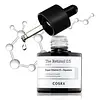What's inside
What's inside
 Key Ingredients
Key Ingredients

 Benefits
Benefits

 Concerns
Concerns

 Ingredients Side-by-side
Ingredients Side-by-side

Water
Skin ConditioningPolysorbate 60
EmulsifyingLactic Acid
BufferingIsopropyl Myristate
EmollientGlyceryl Stearate
EmollientHamamelis Virginiana Water
AstringentStearic Acid
CleansingCetearyl Alcohol
EmollientGlycerin
HumectantSodium Hydroxide
BufferingLeuconostoc/Radish Root Ferment Filtrate
AntimicrobialTartaric Acid
BufferingRetinyl Acetate
Skin ConditioningAlbumen
Skin ConditioningCetyl Alcohol
EmollientBenzyl Alcohol
PerfumingMalic Acid
BufferingOlea Europaea Fruit Oil
MaskingRetinol
Skin ConditioningPichia/Resveratrol Ferment Extract
Skin ConditioningResveratrol Dimethyl Ether
AntioxidantGalactoarabinan
Proline
Skin ConditioningRetinyl Palmitate
Skin ConditioningCitrus Grandis Peel Oil
MaskingCananga Odorata Flower Oil
MaskingBisabolol
MaskingTocopheryl Acetate
AntioxidantAloe Barbadensis Leaf Juice Powder
Skin ConditioningAllantoin
Skin ConditioningDaucus Carota Sativa Root Extract
Skin ConditioningPrunus Amygdalus Dulcis Oil
Skin ConditioningHelianthus Annuus Seed Oil
EmollientChamomilla Recutita Flower Extract
MaskingTocopherol
AntioxidantAlthaea Officinalis Root Extract
Skin ConditioningAlcohol
AntimicrobialCitric Acid
BufferingPolysorbate 20
EmulsifyingPotassium Sorbate
PreservativeLimonene
PerfumingSodium Gluconate
Skin ConditioningBHA
AntioxidantBehenyl Alcohol
EmollientCaprylhydroxamic Acid
Alcohol Denat.
AntimicrobialBHT
AntioxidantXanthan Gum
EmulsifyingPhenoxyethanol
PreservativeWater, Polysorbate 60, Lactic Acid, Isopropyl Myristate, Glyceryl Stearate, Hamamelis Virginiana Water, Stearic Acid, Cetearyl Alcohol, Glycerin, Sodium Hydroxide, Leuconostoc/Radish Root Ferment Filtrate, Tartaric Acid, Retinyl Acetate, Albumen, Cetyl Alcohol, Benzyl Alcohol, Malic Acid, Olea Europaea Fruit Oil, Retinol, Pichia/Resveratrol Ferment Extract, Resveratrol Dimethyl Ether, Galactoarabinan, Proline, Retinyl Palmitate, Citrus Grandis Peel Oil, Cananga Odorata Flower Oil, Bisabolol, Tocopheryl Acetate, Aloe Barbadensis Leaf Juice Powder, Allantoin, Daucus Carota Sativa Root Extract, Prunus Amygdalus Dulcis Oil, Helianthus Annuus Seed Oil, Chamomilla Recutita Flower Extract, Tocopherol, Althaea Officinalis Root Extract, Alcohol, Citric Acid, Polysorbate 20, Potassium Sorbate, Limonene, Sodium Gluconate, BHA, Behenyl Alcohol, Caprylhydroxamic Acid, Alcohol Denat., BHT, Xanthan Gum, Phenoxyethanol
 Reviews
Reviews

Ingredients Explained
These ingredients are found in both products.
Ingredients higher up in an ingredient list are typically present in a larger amount.
BHT is a synthetic antioxidant and preservative.
As an antioxidant, it helps your body fight off free-radicals. Free-radicals are molecules that may damage your skin cells.
As a preservative, it is used to stabilize products and prevent them from degrading. Specifically, BHT prevents degradation from oxidation.
The concerns related to BHT come from oral studies; this ingredient is currently allowed for use by both the FDA and EU.
However, it was recently restricted for use in the UK as of April 2024.
Learn more about BHTRetinol is a gold-standard ingredient for anti-aging. It is a form of Vitamin A and belongs to the class of retinoids that also includes tretinoin.
Why is retinol famous?
It has the most scientific studies backing up its skin benefits out of all the non-prescription ingredients.
Retinol is proven to:
This is why retinol is effective at removing wrinkles, fading dark spots, treating acne, and reducing the appearance of pores.
Studies show retinol is less effective when exposed to UV. Be sure to look for appropriate packaging to keep your retinol potent (similar to Vitamin C).
Using retinol or any retinoids will increase sun-sensitivity in the first few months. Though studies show retinoids increase your skin's natural SPF with continuous use, it is best to always wear sunscreen and sun-protection.
We recommend speaking with a medical professional about using this ingredient during pregnancy.
Retinol may cause irritation in some people, so be sure to patch test. Experts recommend 'ramping up' retinol use: start using this ingredient once a week and work up to using it daily.
Read about Tretinoin
Learn more about RetinolTocopherol (also known as Vitamin E) is a common antioxidant used to help protect the skin from free-radicals and strengthen the skin barrier. It's also fat soluble - this means our skin is great at absorbing it.
Vitamin E also helps keep your natural skin lipids healthy. Your lipid skin barrier naturally consists of lipids, ceramides, and fatty acids. Vitamin E offers extra protection for your skin’s lipid barrier, keeping your skin healthy and nourished.
Another benefit is a bit of UV protection. Vitamin E helps reduce the damage caused by UVB rays. (It should not replace your sunscreen). Combining it with Vitamin C can decrease sunburned cells and hyperpigmentation after UV exposure.
You might have noticed Vitamin E + C often paired together. This is because it is great at stabilizing Vitamin C. Using the two together helps increase the effectiveness of both ingredients.
There are often claims that Vitamin E can reduce/prevent scarring, but these claims haven't been confirmed by scientific research.
Learn more about Tocopherol